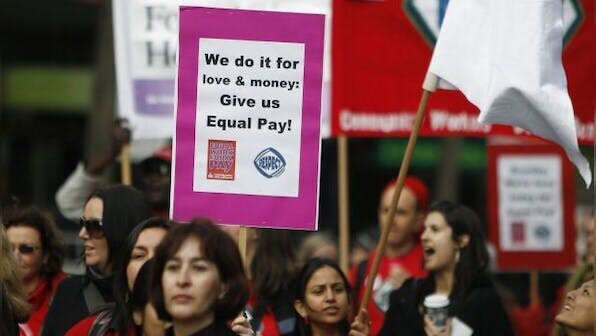Equal pay: the solution is hiding in plain sight

The facts are undeniable. Women in 5,000 companies—covering almost five million workers—earn 21.7 percent less than their male colleagues’ median total remuneration. In some companies, the gap is as high as 31.8 percent. This is according to figures released by the Workplace Gender Equity Agency (WGEA) in the lead-up to International Women’s Day this year.
A significant gender pay disparity in some areas with relatively small numbers of women, such as mining or construction companies, might not be surprising. But others, such as banks and airlines, often have even higher wage gaps. In retail women’s wear, for every dollar a man gets, women’s pay ranges from 42.3 to 79.1 cents.
Importantly, the WGEA figures compare full-time work, with pay rates for part-time work translated into a full-time rate for the purposes of comparison. But because women disproportionately work part time, the actual amount they are paid—what goes into their bank account each fortnight—is even less compared to their male counterparts than what the pay gap alone suggests.
Why does the pay gap exist? The problem is well illustrated by Bain Consulting. Bain is a company with a 31 percent wage gap, despite winning awards from the WGEA for gender equality. At Bain, women make up just 31 percent of its highest earning advisers, 45 percent of its second-highest ranks and 71 percent of its bottom quartile.
A similar situation exists at the Commonwealth Bank, which has a 54.4 percent female workforce. Around 71 percent of the lower-paid customer service roles in branches and call centres are women, which accounts for its 29.8 percent pay gap. The bank may pay the same wage for the same work, but men get the higher paid jobs with all the perks and bonuses that go with them.
The solution, according to Angela Priestley in Women’s Agenda, is to “Bring on the heat around the gender pay gaps ... Bring on the scrutiny ... the awkward discussions” in companies championing the UN’s International Women’s Day slogan “count her in”.
But while it’s welcome that the WGEA has published business names and matching figures of pay rates for the first time, transparency itself won’t necessarily improve things for women. In Denmark, when similar data was published, the gender pay gap narrowed because bosses responded by holding down men’s wages, rather than increasing women’s.
Not mentioned by the WGEA, companies or media commentary is the one thing that has won gains for women in the past—militant union organising.
Since the 1800s, Australian unions have been organising for equal pay. As early as 1902, telegraphists and postmistresses in the new federal public service won equal pay after a determined campaign by the union. Later campaigns during WWII saw tram conductors, munitions workers and bread carters win after taking industrial action.
Two campaigns particularly stand out: one by manufacturing workers in 1969 and the other by insurance workers in 1973. Several industrial campaigns in manufacturing in the early 1960s were instrumental in bringing about the 1969 decision that enshrined equal pay for the same work. This decision triggered a two-year campaign to win full equal pay for 72,000 women process workers. Concerted industrial action, including the unionisation of many new workplaces and joint action with their fellow male workers, got results.
After the second equal pay decision in 1972 broadened the scope for claims by requiring equal pay for comparable work, insurance workers initially relied on the courts to implement pay equality in their industry. When this didn’t happen, they started to organise and in 1973 several thousand workers demonstrated in Melbourne and stayed out for the rest of the day. They then went on to have a stop-work a week later and another strike, and a month later threatened a national strike—the first in the industry. The employers backed down and, though it took another year and a further threat of industrial action, pay equality was won for most of the workforce.
We’ve now had decades of reports, committees, court rulings, new legislation undoing some of the structural barriers to women’s work—and yet the gender pay gap remains stubbornly high. It remains high because union leaders have forgotten the lessons of the past, relied on all these committees and laws instead of the industrial strength of their members.
The 1980s ALP-ACTU Accord promised many things for women, but collaboration with the bosses led to women’s wages falling and big job losses in female-dominated industries as the economy was restructured. Unions held back from taking industrial action, unionisation and wages and conditions plummeted, while the bosses reaped the profits.
In the wake of this latest WGEA report, the ACTU released several memes, concluding that “There is much to be done, but union members are no stranger to getting things done”. Where we have actually won equal pay or broken through barriers, it is because we have used our industrial strength, not meme wars. Where is the call from the ACTU or individual unions for a stop-work on International Women’s Day?
We can’t rely on naming and shaming the bosses into granting equal pay. We have to take on the system that reinforces inequality. If unions were prepared to take on the banks, the supermarkets and the airlines to demand better wages for women and back it up with industrial action—like workers did in the insurance industry in the 1970s—there is every indication it would be popular and they would be under huge pressure to pay up. But for all the talk of “breaking the rules”, there is clearly no appetite for that sort of action.
If we are to break through the gender pay gap, it will be necessary to follow the example of those before us who used their industrial power to win better conditions for women. And to do that, we need to start building power in our workplaces from the bottom up.